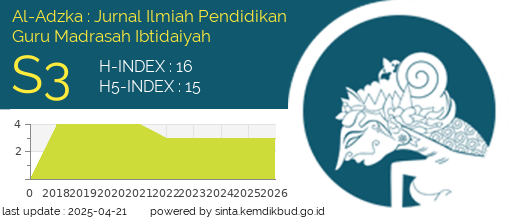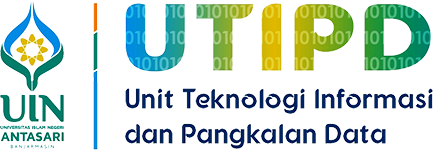The Relationship Between Literacy and Numeracy Skills of Prospective Primary Education Teachers
DOI:
https://doi.org/10.18592/aladzkapgmi.v14i1.12201Keywords:
Aspects of Information Text; Literacy Skills; Literary Text Aspects; Numeracy SkillsAbstract
Literacy and numeracy have become prerequisites for society to improve competence in social life. This research endeavor seeks to establish the correlation between the literacy components found in informational texts and literary texts and their impact on numeracy proficiency. This study involved 207 prospective primary education teachers of the Teacher Education Faculty of Tarbiyah Hamzanwadi Pancor Islamic Institute as the study population. The sampling technique used simple random sampling, so 78 prospective primary education teachers were obtained as research samples. The research findings show that there is a simultaneous relationship between literacy skills in the aspects of informational texts and literary texts with numeracy skills in prospective primary education teachers, Faculty of Tarbiyah, Hamzanwadi Islamic Institute Pancor. The contribution of literacy influence is 52% to increase numeracy ability. In addition, literacy skills in aspects of information texts and aspects of literary texts also partially affect the improvement of numeracy skills in students.References
Cohen, M. D. (2013). Truth & Beauty: Mathematics in Literature. The Mathematics Teacher, 106(7), 534–539. https://doi.org/10.5951/mathteacher.106.7.0534
Cyndi. (2023). Why the Math and Literature Connection is So Important. Ourjourneywestward.Com.
Duncan, G. J., Dowsett, C. J., Claessens, A., Magnuson, K., Huston, A. C., Klebanov, P., Pagani, L. S., Feinstein, L., Engel, M., Brooks-Gunn, J., Sexton, H., Duckworth, K., & Japel, C. (2007). School readiness and later achievement. Developmental Psychology, 43(6), 1428–1446. https://doi.org/10.1037/0012-1649.43.6.1428
Engelhardt, N., & Tubbs, R. (2021). Introduction: Relationships and Connections Between Literature and Mathematics. In The Palgrave Handbook of Literature and Mathematics (pp. 1–20). Springer International Publishing. https://doi.org/10.1007/978-3-030-55478-1_1
Faber, J., & Fonseca, L. M. (2014). How sample size influences research outcomes. Dental Press Journal of Orthodontics, 19(4), 27–29. https://doi.org/10.1590/2176-9451.19.4.027-029.ebo
Gavin, M. (2022). Literary Mathematics. Stanford University Press. https://doi.org/10.1515/9781503633919
Gorard, S., Siddiqui, N., & See, B. H. (2018). Philosophy for children: Evaluation report and executive summary. Education Endowment Foundation.
Gunayasa, I. B. K., Zain, Moh. I., Wardani, K. S. K., & Astria, F. P. (2021). Penyuluhan Tentang Pengembangan Literasi Baca Dan Numerasi Melalui Media Pop Up Box di Sekolah Dasar Se-Kecamatan Praya Lombok Tengah. Jurnal Interaktif: Warta Pengabdian Pendidikan, 1(2), 1–10. https://doi.org/10.29303/interaktif.v1i2.11
Hanemann, U. (2015). Lifelong literacy: Some trends and issues in conceptualising and operationalising literacy from a lifelong learning perspective. International Review of Education, 61(3), 295–326. https://doi.org/10.1007/s11159-015-9490-0
Heyd-Metzuyanim, E., Sharon, A. J., & Baram-Tsabari, A. (2021). Mathematical media literacy in the COVID-19 pandemic and its relation to school mathematics education. Educational Studies in Mathematics, 108(1–2), 201–225. https://doi.org/10.1007/s10649-021-10075-8
Hidayah, I. R., Kusmayadi, T. A., & Fitriana, L. (2021). Minimum Competency Assessment (AKM): An Effort To Photograph Numeracy. Journal of Mathematics and Mathematics Education, 11(1), 14. https://doi.org/10.20961/jmme.v11i1.52742
Hong, J., Thakuriah, P. (Vonu), Mason, P., & Lido, C. (2020). The role of numeracy and financial literacy skills in the relationship between information and communication technology use and travel behaviour. Travel Behaviour and Society, 21, 257–264. https://doi.org/10.1016/j.tbs.2020.07.007
Howard, S. J., Woodcock, S., Ehrich, J., & Bokosmaty, S. (2017). What are standardized literacy and numeracy tests testing? Evidence of the domain‐general contributions to students’ standardized educational test performance. British Journal of Educational Psychology, 87(1), 108–122. https://doi.org/10.1111/bjep.12138
Hu, M., Daley, A., & Warman, C. (2019). Literacy, Numeracy, Technology Skill, and Labour Market Outcomes among Indigenous Peoples in Canada. Canadian Public Policy, 45(1), 48–73. https://doi.org/10.3138/cpp.2017-068
Jalota, R., Trivedi, P., Maheshwari, G., Ngonga Ngomo, A.-C., & Usbeck, R. (2020). An Approach for Ex-Post-Facto Analysis of Knowledge Graph-Driven Chatbots – The DBpedia Chatbot (pp. 19–33). https://doi.org/10.1007/978-3-030-39540-7_2
Kemendikbud. (2021). Panduan Penguatan Penguatan Literasi dan Numerasi di Sekolah. Jakarta: Direktorat Jenderal Pendidikan Anak Usia Dini, Pendidikan Dasar, dan Pendidikan Menengah Kementerian Pendidikan dan Kebudayaan.
Koponen, T., Aunola, K., & Nurmi, J.-E. (2019). Verbal counting skill predicts later math performance and difficulties in middle school. Contemporary Educational Psychology, 59, 101803. https://doi.org/10.1016/j.cedpsych.2019.101803
Kus, M. (2018). Numeracy. Brock Education Journal, 27(2), 58–62. https://doi.org/10.26522/brocked.v27i2.579
Lechner, C. M., Gauly, B., Miyamoto, A., & Wicht, A. (2021). Stability and change in adults’ literacy and numeracy skills: Evidence from two large-scale panel studies. Personality and Individual Differences, 180, 110990. https://doi.org/10.1016/j.paid.2021.110990
Maharani, R. D., & Prabawanto, S. (2022). Students’ numeracy literacy ability viewed by adversity quotient. International Conference On Mathematics And Science Education (ICMScE 2021), 070019. https://doi.org/10.1063/5.0102478
Mata, M. de L., Monteiro, V., & Peixoto, F. (2012). Attitudes towards Mathematics: Effects of Individual, Motivational, and Social Support Factors. Child Development Research, 2012, 1–10. https://doi.org/10.1155/2012/876028
McMillan, J. H., & Schumacher, S. (2006). Research in Education: Evidence-Based Inquiry, Pearson. Boston: MA.
Mentari Putri, L. M., Aini, I. N., Fitriyana, F., & Sriwijayanti, R. P. (2023). Pengaruh Literasi Dan Numerasi Dalam Meningkatkan Hasil Asesemen Kompetensi Minimum Kelas 5 SDN Gading Kulon II Kabupaten Probolinggo Tahun Pelajaran 2022/2023. FASHLUNA, 3(2), 172–181. https://doi.org/10.47625/fashluna.v3i2.408
Neumann, M. M., Hood, M., Ford, R. M., & Neumann, D. L. (2013). Letter and numeral identification: Their relationship with early literacy and numeracy skills. European Early Childhood Education Research Journal, 21(4), 489–501. https://doi.org/10.1080/1350293X.2013.845438
Nursyifa, A., & Masyithoh, S. (2023). Analisis Hubungan Literasi Numerasi Dan Hasil Belajar Siswa. Jurnal Pendidikan Dasar Dan Keguruan, 8(1), 22–29. https://doi.org/10.47435/jpdk.v8i1.1798
Perdana, N. S. (2021). Analysis of Student Readiness in Facing Minimum Competency Assesment. MUKADIMAH: Jurnal Pendidikan, Sejarah, Dan Ilmu-Ilmu Sosial, 5(1), 15–20. https://doi.org/10.30743/mkd.v5i1.3406
Prijowuntato, S. W., Widharyanto, B., & Julie, H. (2022). The Influence of Literacy and Numeracy Skills on the Success of College Students in the Faculty of Teacher Training and Education. Jurnal Pendidikan Ilmu Sosial, 32(2), 173–188. https://doi.org/10.23917/jpis.v32i2.20338
Rini, T. A., Cholifah, P. S., Nuraini, N. L. S., & Margetts, K. (2021). Readiness of Elementary Teachers in Minimum Competency Assessment: Teachers’ Competence in Arranging Literature and Numeration Tests. Profesi Pendidikan Dasar, 8(2), 156–169. https://doi.org/10.23917/ppd.v8i2.16157
Rosyidah, A. N. K., Husniati, H., Widodo, A., & Khair, B. N. (2022). Persepsi Guru Terhadap Implementasi Pembelajaran Literasi Numerasi Pada Masa Pandemi Covid-19 Di SDN Darek Lombok Tengah. Collase (Creative of Learning Students Elementary Education), 5(1), 53–58. https://doi.org/10.22460/collase.v5i1.9979
Sa’dijah, C., Purnomo, H., Abdullah, A. H., Permadi, H., Anwar, L., Cahyowati, E. T. D., & Sa’diyah, M. (2023). Students’ numeracy skills in solving numeracy tasks: Analysis of students of junior high schools. Science and Mathematics Education Research: Current Challenges and Opportunities, 040011. https://doi.org/10.1063/5.0113664
Saifuddin, A. (2013). Metode Penelitian. Yogyakarta: Pustaka Belajar.
Sholeh, M. (2021). Transformational Leadership: Principal Intellectual Stimulation in Improving Teacher Competences. Al-Ta Lim Journal, 28(2), 167–179. https://doi.org/10.15548/jt.v28i2.708
Sholeh, M., Aziz, A., & Kholis, N. (2021). Development Of Teacher Competence in Creative Writing To Actualize Literacy Of Madrasah. ELEMENTARY: Islamic Teacher Journal, 9(2), 183. https://doi.org/10.21043/elementary.v9i2.11903
Statistics Canada. (2013). The Programme for the International Assessment of Adult Competencies. Ottawa: Statistics Canada.
Statistics Canada. (2021). Statistics: Power from Data! In Government of Canada (Issue 12). Ottawa: Statistics Canada.
Sundari, A., & Masri, M. (2021). Kesalahan Siswa SMP Kelas VII Dalam Menyelesaikan Soal Operasi Bentuk Aljabar. Indiktika : Jurnal Inovasi Pendidikan Matematika, 4(1), 1–14. https://doi.org/10.31851/indiktika.v4i1.6482
Tunstall, S. (2016). Words Matter: Discourse and Numeracy. Numeracy, 9(2). https://doi.org/10.5038/1936-4660.9.2.5
Westwood, P. S. (2021a). Numeracy: Defined, Described and in Context. In Teaching for Numeracy Across the Age Range (pp. 1–12). https://doi.org/10.1007/978-981-16-3761-2_1
Westwood, P. S. (2021b). Teaching for Numeracy Across the Age Range. SpringerBriefs in Education. https://doi.org/10.1007/978-981-16-3761-2
Windisch, H. C. (2015). Adults with low Literacy and numeracy skills a Literature review on policy interventions. In OECD Education Working Papers (Vol. 123). OECD Publishing, Paris. https://doi.org/10.1787/5jrxnjdd3r5k-en
Windisch, H. C. (2016). How to motivate adults with low literacy and numeracy skills to engage and persist in learning: A literature review of policy interventions. International Review of Education, 62(3), 279–297. https://doi.org/10.1007/s11159-016-9553-x
Zenkov, A., Zenkov, E., & Belke, A. (2021). A Novel Text Analysis Method: Numerals Reveal the Author. SHS Web of Conferences, 93, 03026. https://doi.org/10.1051/shsconf/20219303026
Zhang, J., Fan, X., Cheung, S. K., Meng, Y., Cai, Z., & Hu, B. Y. (2017). The role of early language abilities on math skills among Chinese children. PLOS ONE, 12(7), e0181074. https://doi.org/10.1371/journal.pone.0181074
Downloads
Published
How to Cite
Issue
Section
License
Copyright (c) 2024 I Gede Ratnaya, Siti Nurul Fitriani, Helfa Durasa and Erlin Erlin

This work is licensed under a Creative Commons Attribution 4.0 International License.
Authors who publish with this journal agree to the following terms:
- Authors retain copyright and grant the journal right of first publication with the work simultaneously licensed under a Creative Commons Attribution 4.0 International that allows others to share the work with an acknowledgement of the work's authorship and initial publication in this journal.
- Authors are able to enter into separate, additional contractual arrangements for the non-exclusive distribution of the journal's published version of the work (e.g., post it to an institutional repository or publish it in a book), with an acknowledgement of its initial publication in this journal.
- Authors are permitted and encouraged to post their work online (e.g., in institutional repositories or on their website) prior to and during the submission process, as it can lead to productive exchanges, as well as earlier and greater citation of published work.












